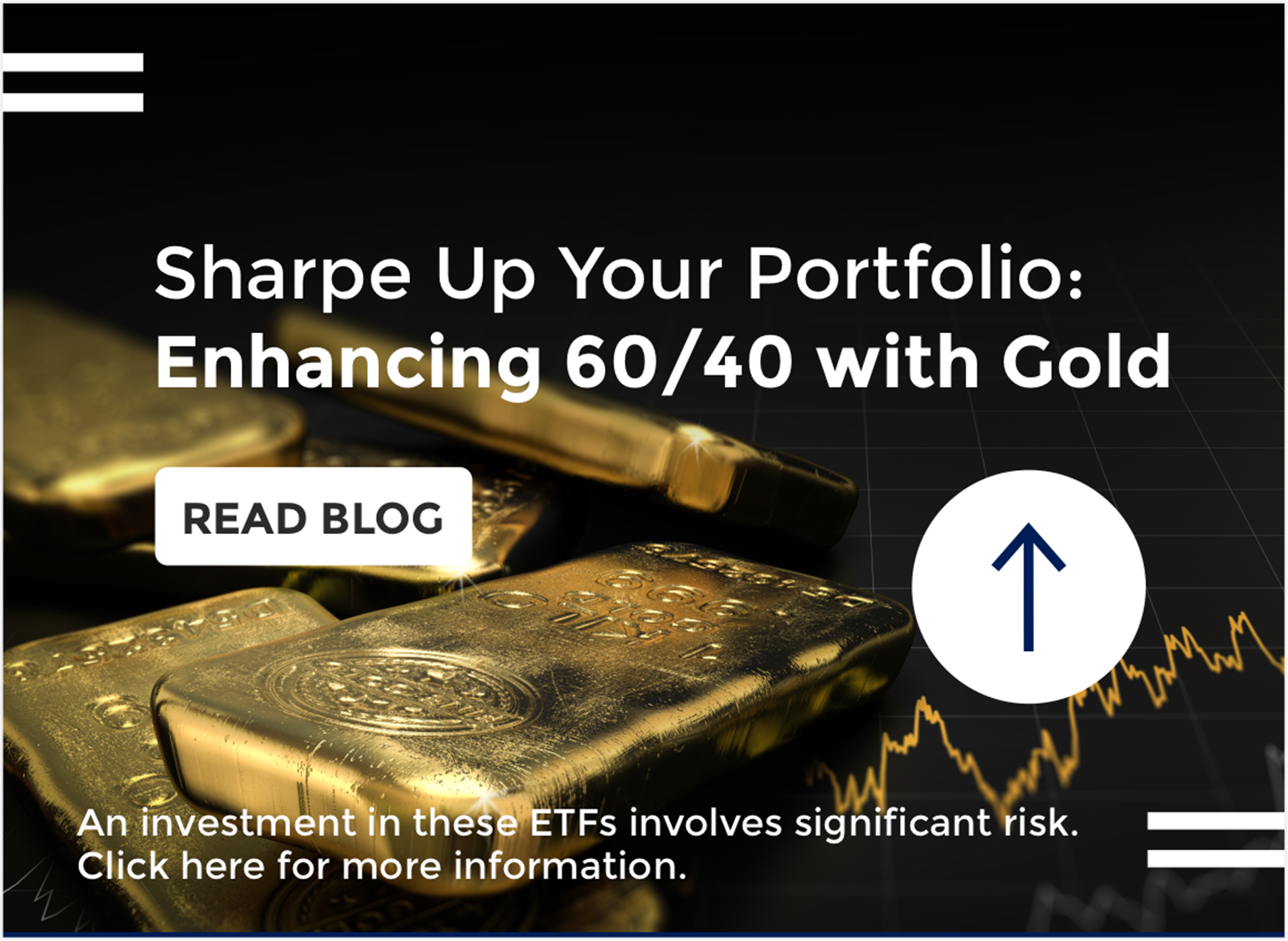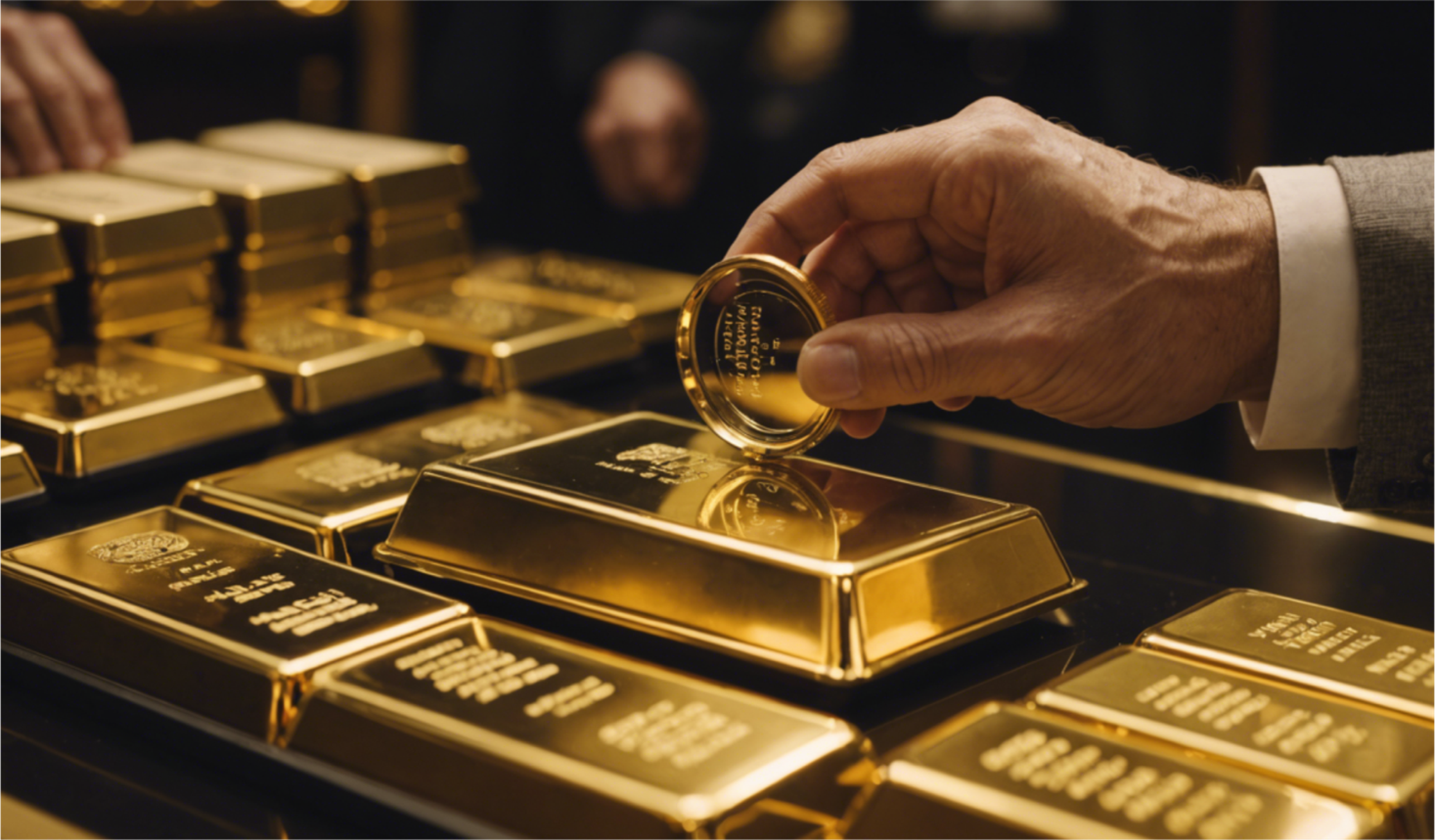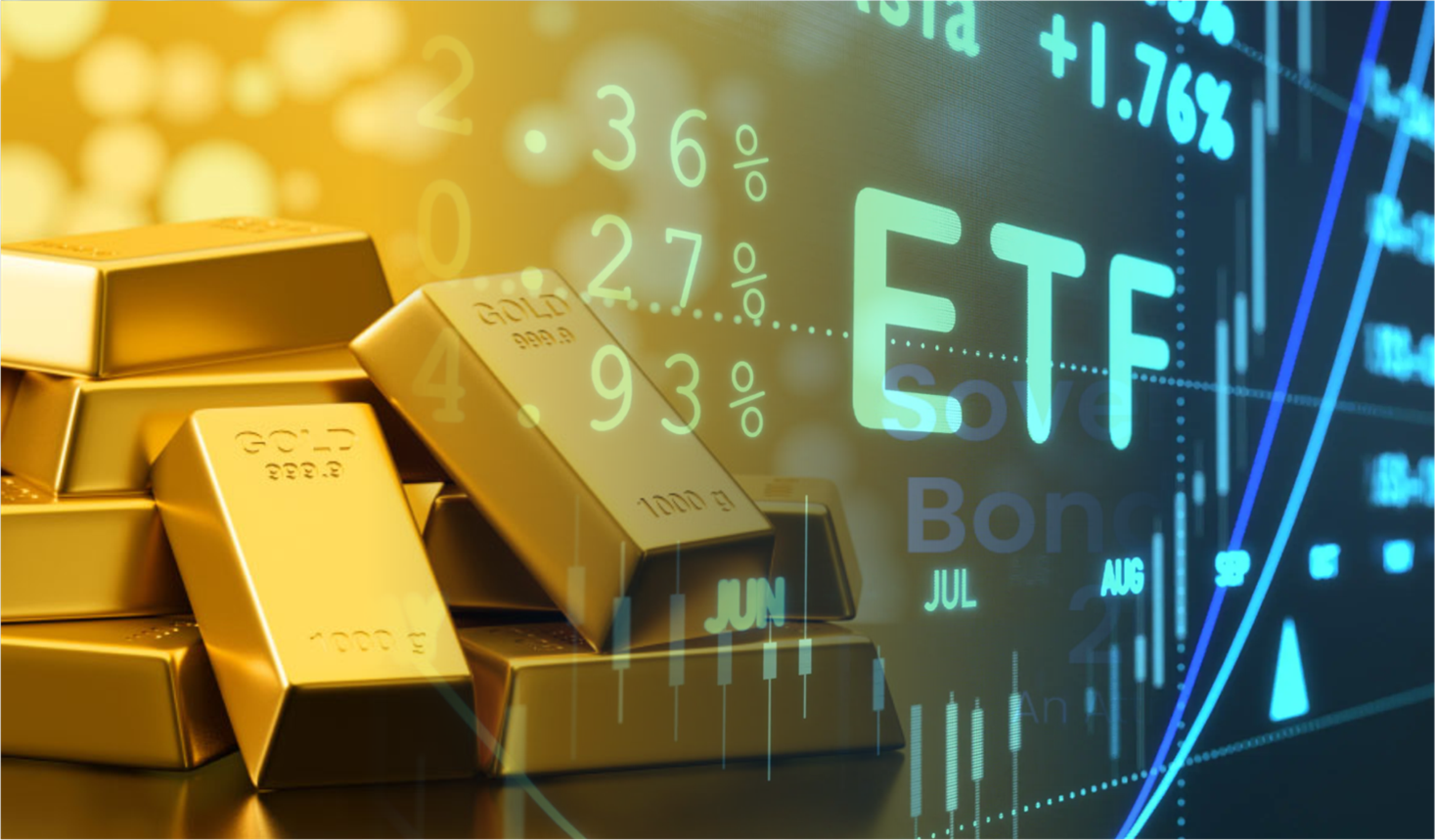Sharpe Up Your Portfolio: Enhancing 60/40 with Gold
Posted:
For decades, the 60/40 portfolio—comprising 60% stocks and 40% bonds—has been the cornerstone of traditional investment strategies. It offers a balanced approach, with stocks providing growth potential and bonds acting as a stabilizing force through income generation and reduced volatility. This mix has historically delivered reliable, risk-adjusted returns, making it a go-to strategy for long-term investors seeking growth while managing downside risk.
However, today’s market environment is presenting new challenges to the 60/40 model. Persistently low bond yields have reduced the income and diversification benefits bonds once offered, while equity markets face increasing volatility driven by inflation concerns, rising interest rates, and global geopolitical tensions. As a result, investors are questioning whether the traditional 60/40 portfolio can still meet their financial goals in the face of these evolving risks.
In response, savvy investors are exploring ways to "Sharpe up" their portfolios—enhancing their risk-adjusted returns by incorporating alternative assets like gold. Gold has long been regarded as a safe haven, particularly during periods of market turbulence. In this article, we’ll explore how adding gold to a 60/40 portfolio can enhance its overall performance, improve the Sharpe ratio, and build resilience against economic uncertainty.
The Sharpe Ratio and Portfolio Efficiency
When building an investment portfolio, it's not just about maximizing returns—managing risk is equally important. One of the most widely used metrics to assess the risk-return tradeoff is the Sharpe Ratio, named after Nobel laureate William F. Sharpe. This ratio measures how much excess return (over the risk-free rate) a portfolio generates for each unit of risk taken, as represented by its volatility.
Understanding the Sharpe Ratio:
Formula:
Sharpe Ratio = Portfolio Return − Risk-Free Rate
` _____________________________
Portfolio Volatility
- Portfolio Return: The overall return generated by the portfolio over a period.
- Risk-Free Rate: Typically the return on government bonds (like U.S. Treasuries), considered to have little to no risk.
- Portfolio Volatility: A measure of how much the portfolio’s returns fluctuate (risk).
A higher Sharpe Ratio indicates that the portfolio is delivering more returns for each unit of risk, making it more efficient. On the other hand, a lower Sharpe Ratio suggests that an investor is taking on more risk without being compensated by higher returns.
Why the Sharpe Ratio Matters:
In today’s uncertain economic environment, simply chasing higher returns isn’t enough. Investors need to ensure that they are adequately compensated for the risks they take. This is where the Sharpe Ratio becomes particularly valuable, as it helps identify portfolios that deliver the best risk-adjusted returns.
For a traditional 60/40 portfolio, the Sharpe Ratio can vary depending on market conditions. However, with bond yields at historic lows and stock market volatility increasing, the risk-adjusted performance of this classic mix has come under pressure. As a result, improving the Sharpe Ratio has become a priority for many investors.
One way to enhance the Sharpe Ratio without taking on significantly more risk is by incorporating non-correlated assets—like gold—that can reduce overall portfolio volatility while still providing returns during times of market stress. In the following sections, we will examine how adding gold can boost portfolio efficiency and improve risk-adjusted performance.
Gold’s Role as a Portfolio Diversifier

When it comes to managing risk and enhancing the efficiency of a portfolio, diversification is key. Gold, as an asset class, has long played a critical role in diversifying portfolios due to its unique characteristics. Unlike stocks and bonds, gold operates largely independent of traditional financial markets, offering protection and stability during periods of uncertainty and economic stress.
Low Correlation with Stocks and Bonds
One of the most compelling reasons to include gold in a diversified portfolio is its historically low or even negative correlation with both stocks and bonds. In times of market downturns or extreme volatility, gold often moves in the opposite direction of equities, providing a buffer against losses. Similarly, during periods of rising inflation or central bank intervention, gold tends to hold its value better than bonds, which are vulnerable to interest rate hikes.
For example:
- During equity market corrections, gold has historically acted as a hedge, gaining in value as investors flock to safe-haven assets.
- When bond yields fall due to monetary policy easing or deflationary pressures, gold's appeal grows as an alternative store of value.
By having a low correlation with both riskier assets like stocks and defensive assets like bonds, gold helps smooth out the volatility in a portfolio, particularly during economic downturns or inflationary periods.
Gold’s Historical Performance During Market Turbulence

Gold's ability to shine during times of crisis is well-documented. Some notable examples include:
- The 2008 Global Financial Crisis: As equities plummeted, gold prices surged, providing a crucial offset to the losses in traditional portfolios.
- The COVID-19 Pandemic: In 2020, gold reached new highs as markets reeled from the uncertainty and economic disruptions caused by the global health crisis.
- Stagflation in the 1970s: Gold's price skyrocketed as inflation soared and economic growth stagnated, proving its value as a hedge against both inflation and currency debasement.
These periods highlight how gold can act as a reliable hedge in times of heightened economic uncertainty, protecting portfolios from sharp drawdowns in traditional assets.
Inflation Hedge and Store of Value
Gold has also earned a reputation as a long-term store of value, particularly in inflationary environments. As inflation erodes the purchasing power of paper currencies and bond yields struggle to keep pace, gold tends to retain, and often increase, its value. This makes it an attractive asset for investors looking to preserve wealth over time.
In recent years, concerns over rising inflation, central bank policies, and geopolitical risks have increased the demand for gold as a strategic asset. Unlike fiat currencies, which can be printed in unlimited quantities, gold’s supply is finite, further enhancing its appeal as a hedge against inflation and currency debasement.
Gold as a Volatility Dampener
Incorporating gold into a traditional 60/40 portfolio doesn’t just reduce risk—it can also help enhance risk-adjusted returns. By mitigating extreme downside volatility, gold enables investors to achieve a smoother return profile, making the overall portfolio more resilient to market shocks.
In the next section, we will explore how you can strategically add gold to your portfolio and the impact it can have on your overall performance.
Potential Risks and Considerations
While gold can enhance a 60/40 portfolio, it comes with potential risks that investors must consider through thorough due diligence.
- No Income Generation
Gold doesn’t generate income, unlike bonds or dividend-paying stocks. For investors seeking regular returns, the lack of interest or dividends could reduce portfolio income. When adding gold, assess whether its defensive qualities outweigh the opportunity cost of missing out on income-generating assets.
- Price Volatility
Although gold is a safe-haven asset, it can still experience volatility, especially when market conditions stabilize. For example, after peaking during crises like the 2008 financial crash and the early pandemic, gold prices declined as riskier assets rebounded. Proper due diligence regarding gold’s volatility and its alignment with your risk tolerance is critical before allocating.
- Overexposure to Commodities
Gold is part of the broader commodity asset class. Allocating too much to gold can concentrate risk, reducing the diversification benefits of your portfolio. To prevent overexposure, most financial experts recommend limiting gold to 5-10% of your portfolio. Careful due diligence ensures that the gold allocation balances growth potential and risk mitigation without introducing unnecessary volatility.
- Costs of Ownership
Investors in gold should consider costs such as storage fees for physical gold or management fees for gold ETFs. Over time, these costs can eat into returns, so it’s crucial to assess whether the protection gold offers outweigh these expenses. Due diligence will help you select the most cost-efficient method to invest in gold.
- Market Timing
Gold’s value often rises during crises, but timing your entry into gold investments can be challenging. Entering gold markets at their peak can limit returns. It’s essential to view gold as a long-term strategic allocation rather than a short-term trade. Investors should conduct careful due diligence to understand the broader market conditions and avoid overreacting to temporary market movements.
Implementing Gold in a Portfolio: Practical Steps
After weighing the risks and performing due diligence, the next step is to decide how to incorporate gold into your portfolio.
- Gold ETFs

Gold-backed exchange-traded funds (ETFs) are one of the most accessible and liquid ways to invest in gold. These ETFs track the price of gold and offer exposure without the hassle of physical storage. ETFs typically have low fees, making them a cost-efficient choice for most investors.
One such option is the GraniteShares Gold Trust (BAR), a low-cost gold ETF designed to track the price of physical gold. With its highly competitive expense ratio of 0.1749%, BAR offers investors an efficient way to gain exposure to gold with minimal cost drag. Investors should review the expense ratio, liquidity, and historical performance of ETFs like GraniteShares BAR as part of their due diligence process.
- Physical Gold
Investing in physical gold (such as bars or coins) provides a tangible asset that you fully own, offering peace of mind in times of financial uncertainty. However, you will need to account for costs such as storage and insurance, as well as the potential lack of liquidity when you decide to sell. Due diligence should include understanding these logistical challenges before opting for physical gold.
- Gold Mining Stocks
Another way to gain exposure to gold is by investing in gold mining companies. These stocks provide leverage to the price of gold, meaning that their value often rises more than the price of gold itself during upswings. However, they also carry company-specific risks, such as operational challenges or geopolitical issues. Due diligence is crucial when selecting individual mining stocks or ETFs that invest in a broad basket of mining companies.
- Gold Futures and Options
For more sophisticated investors, gold futures and options offer ways to speculate on gold prices or hedge against inflation. These instruments are more complex and carry higher risks than direct gold investments. Before diving into futures and options, investors must conduct extensive due diligence to understand the mechanics and risks of these derivatives.
- Allocating Gold Strategically
How much gold should you allocate? While a 5-10% allocation can enhance diversification, it’s important to adjust the allocation based on your individual risk profile and financial goals. Conservative investors might opt for a higher allocation to gold, while more aggressive investors may prefer to keep gold as a smaller portion. Due diligence is critical to finding the right balance for your unique portfolio.
Conclusion: Gold as a Sharper Investment Tool
Incorporating gold into a 60/40 portfolio can be a game-changer for investors seeking to enhance risk-adjusted returns while safeguarding their portfolios against market volatility and inflation. As a non-correlated asset, gold offers a unique diversification benefit, helping reduce portfolio volatility during turbulent times. Whether through ETFs, physical gold, or mining stocks, investors have multiple ways to tap into gold’s defensive properties.
However, adding gold to your portfolio requires careful due diligence. It’s important to weigh the trade-offs, such as the lack of income, price volatility, and associated costs. Additionally, avoiding overexposure to commodities and maintaining a balanced allocation will ensure that gold enhances, rather than hinders, portfolio performance.
In the end, gold’s ability to act as both an inflation hedge and a safe haven during crises makes it a valuable tool for "sharpening up" a 60/40 portfolio. With the right approach, gold can help investors build a more resilient, diversified, and efficient portfolio, positioning them to weather economic uncertainties while maintaining long-term growth potential.
Leveraged ETFs by GraniteShares
| Product name | Ticker |
|---|---|
| US | |
RISK FACTORS AND IMPORTANT INFORMATION
This material must be preceded or accompanied by a Prospectus. Carefully consider the Fund’s investment objectives risk factors, charges and expenses before investing. Please read the prospectus before investing.
The Fund is not suitable for all investors. The investment program of the funds is speculative, entails substantial risks and include asset classes and investment techniques not employed by most ETFs and mutual funds. Investments in the ETFs are not bank deposits and are not insured or guaranteed by the Federal Deposit Insurance Corporation or any other government agency.The Fund is designed to be utilized only by knowledgeable investors who understand the potential consequences of seeking daily leveraged (2X) investment results, understand the risks associated with the use of leverage and are willing to monitor their portfolios frequently. For periods longer than a single day, the Fund will lose money if the Underlying Stock’s performance is flat, and it is possible that the Fund will lose money even if the Underlying Stock’s performance increases over a period longer than a single day. An investor could lose the full principal value of his/her investment within a single day.
The Fund seeks daily leveraged investment results and are intended to be used as short-term trading vehicles. This Fund attempts to provide daily investment results that correspond to the respective long leveraged multiple of the performance of its underlying stock (a Leverage Long Fund).
Investors should note that such Leverage Long Fund pursues daily leveraged investment objectives, which means that the Fund is riskier than alternatives that do not use leverage because the Fund magnifies the performance of its underlying stock. The volatility of the underlying security may affect a Funds' return as much as, or more than, the return of the underlying security.
Because of daily rebalancing and the compounding of each day’s return over time, the return of the Fund for periods longer than a single day will be the result of each day’s returns compounded over the period, which will very likely differ from 200% of the return of the Underlying Stock over the same period. The Fund will lose money if the Underlying Stock’s performance is flat over time, and as a result of daily rebalancing, the Underlying Stock volatility and the effects of compounding, it is even possible that the Fund will lose money over time while the Underlying Stock's performance increases over a period longer than a single day.
Shares are bought and sold at market price (not NAV) and are not individually redeemed from the ETF. There can be no guarantee that an active trading market for ETF shares will develop or be maintained, or that their listing will continue or remain unchanged. Buying or selling ETF shares on an exchange may require the payment of brokerage commissions and frequent trading may incur brokerage costs that detract significantly from investment returns.
An investment in the Fund involves risk, including the possible loss of principal. The Fund is non-diversified and includes risks associated with the Fund concentrating its investments in a particular industry, sector, or geographic region which can result in increased volatility. The use of derivatives such as futures contracts and swaps are subject to market risks that may cause their price to fluctuate over time. Risks of the Fund include Effects of Compounding and Market Volatility Risk, Leverage Risk, Market Risk, Counterparty Risk, Rebalancing Risk, Intra-Day Investment Risk, Other Investment Companies (including ETFs) Risk, and risks specific to the securities of the Underlying Stock and the sector in which it operates. These and other risks can be found in the prospectus.
This information is not an offer to sell or a solicitation of an offer to buy shares of any Funds to any person in any jurisdiction in which an offer, solicitation, purchase or sale would be unlawful under the securities laws of such jurisdiction. Please consult your tax advisor about the tax consequences of an investment in Fund shares, including the possible application of foreign, state, and local tax laws. You could lose money by investing in the ETFs. There can be no assurance that the investment objective of the Funds will be achieved. None of the Funds should be relied upon as a complete investment program.
The Fund is distributed by ALPS Distributors, Inc, which is not affiliated with GraniteShares or any of its affiliates ©2024 GraniteShares Inc. All rights reserved. GraniteShares, GraniteShares Trusts, and the GraniteShares logo are registered and unregistered trademarks of GraniteShares Inc., in the United States and elsewhere. All other marks are the property of their respective owners

